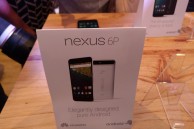
Google today announced the launch of the Nexus 6P and the Nexus 5X at an event in New Delhi, India today. Beside revealing the prices of both devices, the company also had demo units of them at the event. I managed to spend quite a bit of time with the Huawei-made Nexus 6P, and here is what I think about it.
Build Quality
The first thing that I immediately noticed about the Nexus 6P when I picked it up, was how light it is. Despite coming with a 5.7-inch Super-AMOLED display and an “aero-grade aluminium” body, the handset feels extremely light. The build quality of the handset is pretty outstanding, especially when compared to previous Nexus offerings. In comparison, the LG-made Nexus 5X feels like a plastic toy.
While Google boasts about the screen-to-body ratio of the Nexus 6P, it is not that impressive. Yes, it is not as bad as the iPhone 6s Plus, but it is not as good as the Nexus 6 either. The front-facing stereo speakers are partially to blame here, but they make up for it by being surprisingly loud and clear. They are not as boomy and punchy as the BoomSound speakers on the One M8, but I think Google made the perfect sacrifice in terms of performance and bezel size here, unlike HTC.
Display

The 5.7-inch Quad HD display on the Nexus 6P has typical characteristics of Super AMOLED: sharp and vivid with great viewing angles. Watching any kind of media on the device was a treat thanks to the combination of the front facing stereo speakers and how colors simply popped on the display. I cannot comment on the accuracy or brightness levels, since it is difficult to judge them in event lighting. However, I did not notice any yellow or purple fringing that the Super AMOLED panel on the Nexus 6 was known for.
Since the Nexus 6P runs on the fiery Snapdragon 810 chipset and features an aluminium body, many people have been worried about the handset overheating, just like any other Snapdragon 810 powered device. However, despite using the device continuously at full brightness, shooting pictures, and recording videos, the Nexus 6P did not get warm. Now, I am not saying that the handset might not suffer from overheating issues here. All I am saying is that unlike the One M9 and G Flex 2, the overheating issues on the Nexus 6P will likely be few and far between.
Camera
Nexus handsets have never been known for their camera performance, but Google is trying its best to change that with the Nexus 5X and Nexus 6P. Both handsets come with a 12.3MP rear shooter with an F/2.0 aperture and 1.55um pixel size. In my limited time with the Nexus 6P, I was mighty impressed with its rear shooter. Not only has Google improved the camera hardware dramatically, it has also updated its Google Camera app to make the experience significantly better.
The camera app constantly opened up within a second of double pressing the power button. The device was also quick to take pictures, and there was no noticeable shutter or shot-to-shot lag. Compared to the existing Google Camera app, the new app features a sleeker UI with more intuitive controls that makes it a pleasure to use. It still does not provide manual control over any aspect of the camera, but this problem can be easily solved by using a third-party app from Google Play.
You can find some camera samples from the phone below.
I don’t really expect the camera performance of Nexus 6P to beat the likes of the Galaxy S6, LG G4, and iPhone 6s Plus in low-light, but its overall performance should be right up there with them.
Last year, there were multiple rumors that Google was planning on killing its Nexus brand. The rebranded Moto X Pro as Nexus 6 did not help things either. This year though, the company is back with what is undoubtedly the best Nexus handset it has ever released. However, I will prefer to reserve my final judgement about the device until I get my hands on the retail unit and do a full review.





















